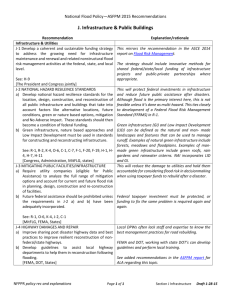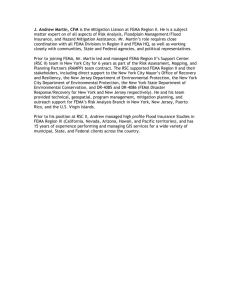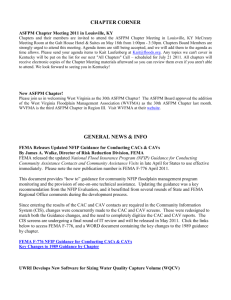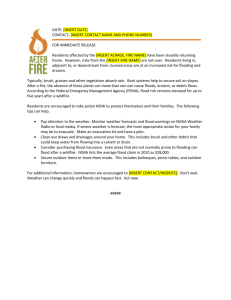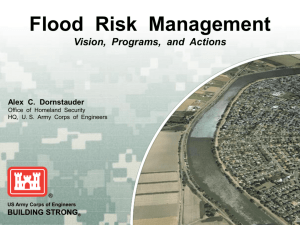Building State & Local Capability
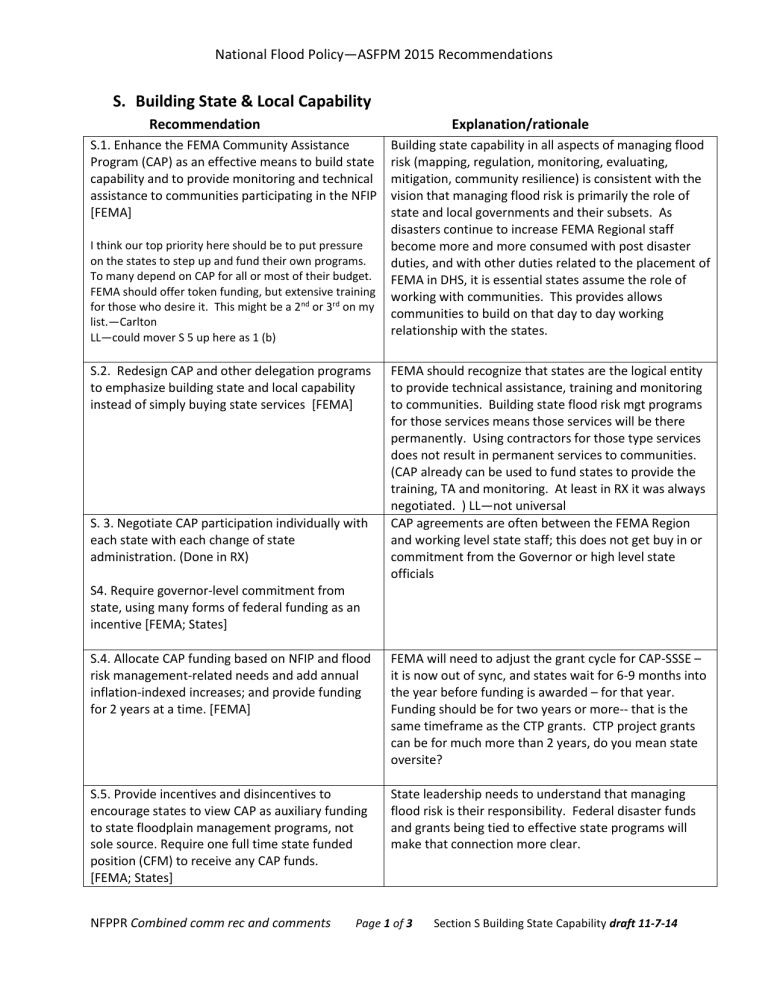
National Flood Policy—ASFPM 2015 Recommendations
S.
Building State & Local Capability
Recommendation
S.1. Enhance the FEMA Community Assistance
Program (CAP) as an effective means to build state capability and to provide monitoring and technical assistance to communities participating in the NFIP
[FEMA]
I think our top priority here should be to put pressure on the states to step up and fund their own programs.
To many depend on CAP for all or most of their budget.
FEMA should offer token funding, but extensive training for those who desire it. This might be a 2 nd or 3 rd on my list.—Carlton
LL—could mover S 5 up here as 1 (b)
S.2. Redesign CAP and other delegation programs to emphasize building state and local capability instead of simply buying state services [FEMA]
Explanation/rationale
Building state capability in all aspects of managing flood risk (mapping, regulation, monitoring, evaluating, mitigation, community resilience) is consistent with the vision that managing flood risk is primarily the role of state and local governments and their subsets. As disasters continue to increase FEMA Regional staff become more and more consumed with post disaster duties, and with other duties related to the placement of
FEMA in DHS, it is essential states assume the role of working with communities. This provides allows communities to build on that day to day working relationship with the states.
FEMA should recognize that states are the logical entity to provide technical assistance, training and monitoring to communities. Building state flood risk mgt programs for those services means those services will be there permanently. Using contractors for those type services does not result in permanent services to communities.
(CAP already can be used to fund states to provide the training, TA and monitoring. At least in RX it was always negotiated. ) LL—not universal
CAP agreements are often between the FEMA Region and working level state staff; this does not get buy in or commitment from the Governor or high level state officials
S. 3. Negotiate CAP participation individually with each state with each change of state administration. (Done in RX)
S4. Require governor-level commitment from state, using many forms of federal funding as an incentive [FEMA; States]
S.4. Allocate CAP funding based on NFIP and flood risk management-related needs and add annual inflation-indexed increases; and provide funding for 2 years at a time. [FEMA]
S.5. Provide incentives and disincentives to encourage states to view CAP as auxiliary funding to state floodplain management programs, not sole source. Require one full time state funded position (CFM) to receive any CAP funds.
[FEMA; States]
FEMA will need to adjust the grant cycle for CAP-SSSE – it is now out of sync, and states wait for 6-9 months into the year before funding is awarded – for that year.
Funding should be for two years or more-- that is the same timeframe as the CTP grants. CTP project grants can be for much more than 2 years, do you mean state oversite?
State leadership needs to understand that managing flood risk is their responsibility. Federal disaster funds and grants being tied to effective state programs will make that connection more clear.
NFPPR Combined comm rec and comments Page 1 of 3 Section S Building State Capability draft 11-7-14
National Flood Policy—ASFPM 2015 Recommendations
S.6. Allow states to allocate up to 30% of CAP funding to state-selected non NFIP, but effective flood loss reduction activities (not projects). If states can verify the benefit of these other actions, it could be cost effective to the NFIP and disaster funding. [FEMA; states]
S.7. All FEMA Regions should annually host meeting/training with State NFIP coordinators and
SHMOs [FEMA] (Ongoing in RX for years and I think most regions are moving in this direction)
S.8. Support state efforts to require the Floodplain
Administrator in participating NFIP communities be a CFM. [FEMA; ASFPM; states]
S.9.. Explore use of true delegation model to move responsibility for NFIP activities to qualified states
(mapping, monitoring communities for compliance, technical assistance, training, etc.)
Examples of such activities could include working in developing and implementing and training on stronger building codes, Governor executive orders or other state actions that reduce flood insurance claims. (Are we sure they already can’t do this as far as FEMA HQ is concerned?)
An effective NFIP and an effective mitigation program work hand in hand to manage flood risk. Cross training and collaboration of these staff are critical to FEMA’s success and the states success.
Some credit is given in CRS for having a CFM. A number of states are interested in pursuing this avenue, and assistance from FEMA and ASFPM is needed.
S.10. Support and provide incentives to states in efforts to encourage progressive state and local programs and activities, including NAI approaches
(e.g. explore allowing states and counties with land use authority to participate in the CRS program) [Administration; FEMA; MitFLG]
(Counties already participate in CRS – but only for unincorporated land and communities can get credit now for what the county or state does if it is applicable.)
S.11. Provide incentives to encourage communities to integrate floodplain management with land use and watershed conservation plans. Require in
Hazard Mitigation Plans and for credit of flood plans in CRS. [MitFLG; FEMA; EPA; NOAA; HUD]
R.12. ASFPM should analyze “Effective State
Other agencies, such as EPA and DOT fully delegate programs to qualified states; then the federal agency monitors and evaluates the work by the state to determine if the delegation should continue. Stepped delegation should be considered as the state gains more capability and based on effectiveness of the effort.
While the benefits are many, a number of states do not invest in flood risk management/reduction because they either think it is the job of the federal government or they think the federal taxpayers will bail them out after disasters or they do not see an immediate return on investment. Any steps that lead in that direction are useful.
Mitigation plans are increasingly tied to land use or local comprehensive plans. Water conservation plans is more difficult as it differs across the country and communities.
However, EPA and other agencies now have resilience programs that can tie into mitigation planning.
There should be some minimum standards for state
NFPPR Combined comm rec and comments Page 2 of 3 Section S Building State Capability draft 11-7-14
National Flood Policy—ASFPM 2015 Recommendations
Programs” and work with states to encourage states to move beyond basic and toward model flood risk management programs, including an analysis of existing similar programs, such as the
USACE Silver Jackets program. [ASFPM]
S.13. Work with States to examine and upgrade their entire suite of flood risk management policies and programs: floodplain regulations, building codes, dam and levee programs, intra-agency coordination, laws, executive orders, where state funds are spent, grants, their mitigation efforts, etc. [ASFPM Foundation; ASFPM Chapters; ASFPM]
FEMA and the Corps could help.
S.14. Provide incentives to encourage states to issue and enforce effective executive orders or laws on floodplain management
S.15. Work with state insurance and realtor regulators to integrate NFIP and flood risk management into on-going (yearly or biennial)
Continuing Education Credits requirements for insurance agents selling flood insurance and to build agent training capacity in the state. [ASFPM
Chapters; State floodplain mgt offices; FEMA]
S.16 Work with states on transfer of property laws to incorporate flood risk disclosure for property transfers. [ASFPM Chapters; State; FEMA] programs, which ASFPM should work with states/feds to create and promote. (WE should consider a scoring program Gold, Silver, Bronze, dirt levels of state programs.) Love it--LL
The ASFPM Foundation has developed a process to help states conduct a state symposium on flood risk management to identify gaps and opportunities; Follow up efforts at the state level move the discussion to state decision makers with assistance available.
This could be one of a number of factors in a sliding cost share for disaster relief; points in grant awards, etc.
Training of insurance agents becomes even more critical as flood insurance premiums move toward actuarial.
Knowing the accurate current and future premiums as well as mitigation options and costs is key for property owners to make good property investment decisions.
This should be part of an effective state program.
There can also be incentives for effective laws or regs like this
NFPPR Combined comm rec and comments Page 3 of 3 Section S Building State Capability draft 11-7-14
